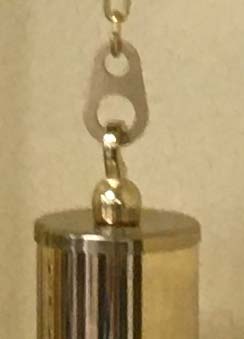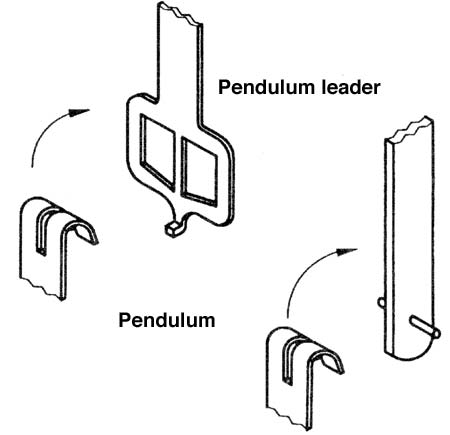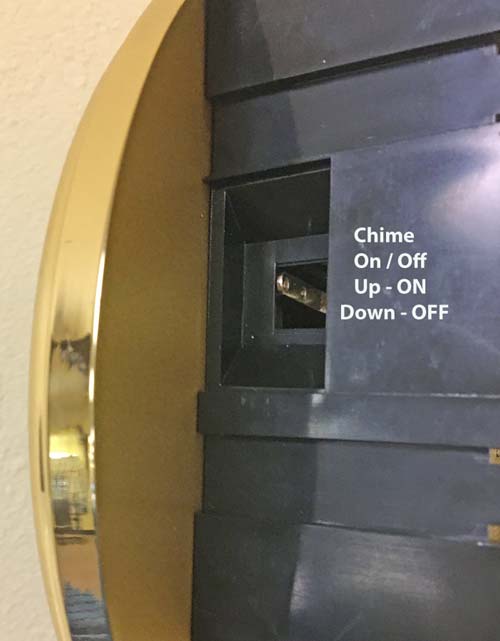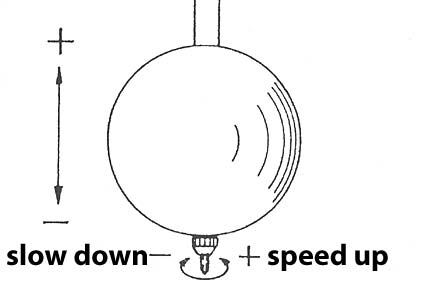Instructions for Hermle Wall Clocks with Mechanical Hour and Half-hour Strike Movement
Posted on January 27, 2021 | By clockde
Instructions for Hermle Wall Clocks with Mechanical Hour and Half-hour Strike Movement
1) Unpacking the clock.
Carefully remove the clock from the packing. You should have a clock body, two weights, and a pendulum.
Now…hang the clock body securely on the wall.
2) Transportation securing devices
Carefully remove the protective packaging such as foam rubber from the bell and remove the polybag holding the chains.
3) Hanging the clock
Hang up the clock so that it is vertical. The best hanger is a wood screw and screwed into a stud in the wall.
4) Hanging the weights.
Remove the twist-ties holding the chains together at the base of the body and hang the weights on the tabs as shown below.
5) Attaching the pendulum
Hang the pendulum onto the pendulum leader (see illustration 1).
6) Starting the pendulum
Move the pendulum slightly to the left or right and release it gently. You should hear an even “tic – toc” sound. If the tic-toc is uneven or the clock stops, follow the “putting in beat” procedure in step 7.
7) Putting the clock in beat
Putting the clock in beat is the responsibility of the clock owner. While the clock was in beat when it left the factory, it may get out of beat during handling. It is a simple process, once you have tried it a few times.
Putting the clock in beat is an adjustment to make the tic and toc evenly spaced. There is a slip clutch mechanism in the clock’s escapement (the part that makes the ticking sound and operates the pendulum). The slip clutch is operated by pushing the pendulum leader (see illustration 2) slightly past the point where you feel a resistance.
To put the clock in beat: Make sure the clock is hanging straight. Listen to the tic toc. Gently push the pendulum leader slightly past the point of resistance. Listen to the tic toc again. If it is more uneven, push the leader in the opposite direction and listen to the tic tock again. After several tries, you will be able to get the tic and toc sound to be evenly spaced, and the clock is then “in beat”.
8) Strike
Your clock strikes once on each half-hour and strikes the number of each hour.
There is a strike shut-off lever located beneath the movement or outside the numeral 2 of the dial.
UP – CHIME ON
DOWN – CHIME OFF
9) Setting the clock
The minute hand (long hand) may be moved clockwise or counterclockwise to set the clock to the correct time. Never turn the hour (short) hand, it moves automatically.
If the clock is striking the wrong hour, move the hour hand (short hand) to point to the hour that the clock just struck.
10) Regulating the clock
To make the clock run slower – turn the regulating nut below the pendulum to the left (see illustration 2).
To make the clock run faster – turn the regulating nut to the right.
One turn of the regulating nut changes the clock’s rate by approximately 1 minute per day. An accuracy of 2 – 5 minutes per week is typical.
Illustration 1 – attaching the pendulum to the pendulum leader |
|
|
Illustration 2 – Regulating the timekeeping by using the regulating nut at the bottom of the pendulum |





Recent Comments